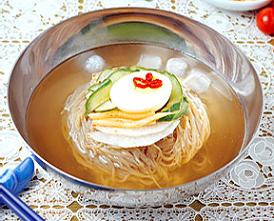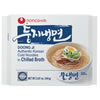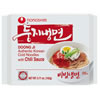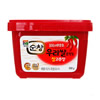| |
| |
 |
|
|
Naeng-myun
Buckwheat Noodles
냉면 |
| |
|
Naeng myun literally means cold noodles and it is one of Koreans favorite dishes during the summer. It consists of thin noodles typically made from arrowroot or buckwheat flour, and is served in a large bowl with a tangy iced broth. It is garnished with sliced beef or pork, a boiled half egg, slices of Asian pear, and sliced cucumber, sprinkled with chopped scallions and sesame seeds.
Two main varieties of naeng myuns exists: mul naeng myun and bibim naeng myun. The former variety is served as a cold soup with the noodles contained in broth (usually beef). The latter variety is served as more of a salad in a spicy dressing made primarily from gochujang which is red chili pepper paste. Although these are the two major variations of this dish, several others do exist, typically varying either in the composition of the broth, meat or vegetables. Also, traditionally, the broth for naeng myun is made with about ⅓ beef broth, ⅓ chicken broth, and ⅓ kimchi brine. But because few people have easy access to all three components, most Koreans use just beef broth or chicken broth.
Since naeng myun is a cold dish as indicated by its name, you would think that it is popular mainly during the summer, but many people enjoy it during the winter as well. There are many restaurants that specialize only in this dish so be sure to try the mild mul naeng myun before sampling the spicier bibim naeng myun.
|
- 1 package of buckwheat noodles
- 1 carton of chicken or beef broth
- Vinegar (brown preferred but white vinegar can be used as a substitute)
- 1 cucumber, peeled, deseeded, and thinly sliced
- 1 Asian pear, peeled and thinly sliced
- Soft boiled egg - one for each person
- Sea salt
|
- Pour chicken or beef broth into a large bowl. Add 2 tbsp of vinegar, stir gently, and taste. If you prefer more of a tang flavor to your broth, add more vinegar to meet taste. Additionally, add a small amount of sea salt to meet taste.
- If you have at least an hour before mealtime, put this bowl of broth in the refrigerator to chill. If you don't have the time to chill the broth in the refrigerator for an hour before serving, place a few ice cubes in each person's bowl to chill while eating.
- Peel cucumber and deseed with a spoon. Then slice into thin strips about 2 inches long. Peel pear and also thinnly slice into julienne pieces.
- Put buckwheat noodles into a large pot of boiling water and cook for 3-4 minutes. They should be taken out as soon as they are al dente (chewy and not too soft). At this point, put noodles in a large colander and rinse 2 to 3 times with cold water. Allow noodles to rest in the colander for a few minutes or until excess water has been drained.
- To serve, place a large handful of noodles in a large eating bowl. Add a small bunch of cucumber strips, a few pear slices, and one soft boiled egg (cut in half right before serving) to the bowl. Then use a ladle to add a generous amount of cold and tangy broth to the bowl, enough to cover about 75 percent of the ingredients.
- Right before eating, feel free to use scissors to cut the noodles a few times to allow for more convenient mouthfuls.
- Also, traditional mool naeng myun comes with a few strips of beef, so if you don't eat beef, be sure to mention this when you order it at a restaurant.
|
| Featured Items: Click & Shop |
|
|






